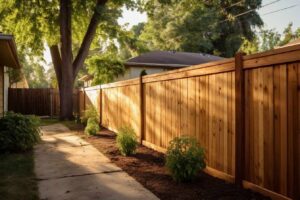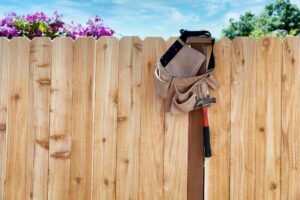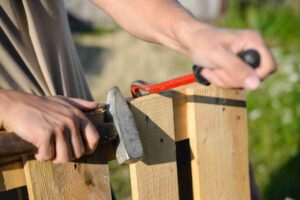Can You Use Landscape Timbers for Fence Posts?
Landscape timbers are large pieces of wood, typically pressure-treated and used in various outdoor landscaping projects. They are commonly used for creating borders around garden beds, retaining walls, steps, and walkways. You can find them in various sizes, with 4×4, 4×6, and 6×6 being the most popular.
If you have extra timbers lying around, or if you can get them for a good price, you may be wondering if you can use landscape timbers as fence posts when installing a new fence. Top Rail Fence has the answers, so let’s dig in.
Difference Between Landscape Timbers and T-Posts
Landscape timbers and T-Posts serve different purposes in the realm of landscaping and fencing. T-Posts are primarily used for fencing, particularly for wire fencing, as they come with clips that make wire attachment easy. They are designed for quick installation and are often used for temporary or movable fences.
On the other hand, landscape timbers are primarily used for landscaping purposes as mentioned earlier.
Can You Use Landscape Timbers for Fence Posts?
Yes, you can use landscape timbers for fence posts. The main advantage of using landscape timbers as fence posts is their strength and ability to handle a significant load. This makes them ideal for use in a privacy fence or in areas with high winds or other stresses. However, they may not be suitable for all fencing types, particularly lightweight or wire fencing, where a more flexible post might be preferable.
Where to Acquire Landscape Timbers
Landscape timbers can be purchased at most home improvement stores, lumber yards, and some garden centers. They are relatively affordable compared to other types of landscaping materials, which makes them a popular choice among homeowners. Online marketplaces are also a good place to find and purchase landscape timbers.
Treating Landscape Timbers for Fence Posts
If you decide to use landscape timbers for fence posts, it’s crucial to treat them first. Since they will be exposed to the elements and will be in contact with the ground, they need to be resistant to rot and pests. Most landscape timbers come pre-treated with a type of wood preservative, but if yours are not, you will need to do this step yourself.
There are various types of wood preservatives available on the market, such as copper naphthenate or pentachlorophenol. Simply apply the preservative according to the manufacturer’s instructions, usually by painting it on, and allow the timber to dry completely before installation.
Installing Landscape Timbers for Fence Posts
Tools You Need to Install Landscape Timbers as Fence Posts:
- Landscape timbers
- Wood preservative (if timbers are not pre-treated)
- Shovel or post-hole digger
- Gravel for drainage
- Concrete for setting posts
- Spirit level
- Measuring tape
How to Install Landscape Timbers as Fence Posts
- Start by marking out the position of your fence posts – ensure that you have accurately measured your yard first.
- Dig a hole at each mark that is three times the width and one-third to half the height of your landscape timber.
- Place a few inches of gravel in the bottom of the hole for drainage.
- Position the landscape timber in the hole. Make sure it is vertical by using a spirit level.
- Once you’re sure it’s positioned correctly, pour concrete into the hole up to ground level.
- Use a stick to poke down into the concrete to remove any air pockets.
- Check the post again with the spirit level to make sure it’s still straight. Adjust if necessary.
- Allow the concrete to set for at least 24 hours before attaching any fencing to the posts.
Final Thoughts
Using landscape timbers for fence posts can be an economical and sturdy solution for your fencing needs. However, remember that landscape timbers might only be suitable for some situations, and regular maintenance is necessary to prolong the life of the wood. If at all for outdoor use, always ensure that your timbers are well-treated to resist rot and pests. When in doubt, it’s always advised to consult a professional fence company.


